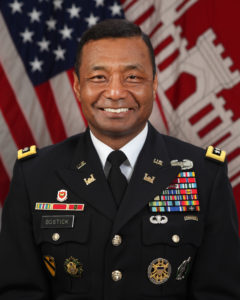A conversation with recently retired U.S. Army Chief of Engineers Thomas Bostick
 The Concord® team recently sat down with Thomas Bostick, the 53rd Chief of Engineers of the United States Army and Commanding General of the U.S. Army Corps of Engineers.
The Concord® team recently sat down with Thomas Bostick, the 53rd Chief of Engineers of the United States Army and Commanding General of the U.S. Army Corps of Engineers.
Bostick’s extraordinary list of accomplishments includes multiple science and engineering degrees from the U.S. Military Academy, Stanford University, and George Washington University, along with an extensive military education and more than three decades of exemplary service including time on the ground in Bosnia and Herzegovina, Iraq and within the Pentagon after 9/11. He is highly decorated, with more than a dozen honors to his name.
In this interview, Bostick emphasizes the need to build organizations around people, by finding, recruiting and developing the most talented professionals in the field.
1 | To build leaders, first recognize the importance of people.
Bostick said the first step to building an exceptional team is simple: Recognize the importance of people. Work hard to bring the right people in, and then work even harder to educate, train and develop them. Don’t leave people on their own after they’ve been recruited– you must guide, help and support them. This is the best way to prepare the next generation to lead, he said.
“I spent a year as a White House Fellow, and I worked in the Department of Veterans Affairs. It could make sense that you would have a doctor running veterans’ hospitals, because of their technical skills. But we never trained many of these doctors to be the leaders and the managers that they needed to be, in order to run these big organizations.
“So they had medical skills, but not necessarily the skills of leadership and motivation, teamwork, achieving success, mentoring and developing those kinds of skills in others; skills needed in military Doctors. But even there, I found it very challenging, and a conscious effort was required to support the development of these skills.”
In addition to talent management, knowledge management is very important. That’s the explicit knowledge, and the tacit knowledge.
Thomas Bostick Tweet
2 | Use an aspirational survey to identify and develop future leaders.
The best way to keep top people in your organization is through a conscious, deliberate effort to develop their talent, Bostick says. This means providing education and challenging job opportunities that help develop new skills.
Consider circulating an aspirational survey to identify your most ambitious and talented team members. This is the most effective way to find out who wants to be mentored, Bostick says. The highly detailed aspirational survey seeks to discover who your people are, and how high they’re aiming in their careers. Once you’ve identified those who are aspiring for training and opportunity, then assign a senior team member to help them get the education and work experience they need to succeed and advance.
“We sent our first civilians, ever, to work on the Hill, as a Congressional liaison. This is a scholarship program that is typically reserved mostly for the military, at the Captain level.
“Very junior people were selected, and we let them work on the Hill. As a result, they came to understand the way government works very early on. They understand authorizations and appropriations. They developed an understanding of how a big part of our country works. This is important because a third of our GDP is from the federal government. This understanding of government should start early. Unless you focus on that at an early age, it becomes very difficult to teach later on.”
3 | Make sure everyone is managing for diversity and inclusion.
One of Bostick’s main passions is managing for diversity and inclusion. The key, he said, is to ensure that people at all levels of the organization are working to identify and keep strong female and minority candidates. “It doesn’t happen by accident,” he said. “It’s a conscious, specific effort. If you don’t do it, you will lose them.” In one example, a friend from Harvard called him to say the Army Corps of Engineers was about to lose a highly educated young woman because someone felt that she had no future in the Corps because she missed a gate in her professional development which could have been easily addressed. Bostick asked him to explain:
“My friend told me that this young woman was a combat engineer, a Harvard graduate and a Rhodes Scholar. You know, the Rhodes Scholarship is probably the most exclusive, prestigious academic scholarship in the world. And yet someone at the lower level told her that she has no future in the Corp of Engineers.
“I called our head of personnel, but it was too late. She had transferred into another branch of service, and we lost her. That’s why I believe the intermediate leaders need to be trained on talent management and understand the importance of managing the small and talented minority members on their teams. They need no special favor, but they do need to be managed with the understanding that they are key to the team’s success. Even if senior leaders make their intentions clear on diversity, inclusion and talent management, there are intermediate leaders that don’t have your experience and will not go out of their way to invest the time that is necessary in working these individual cases.”
The Army Corps of Engineers lost that young Rhodes Scholar, and in a similar situation, very nearly lost a young black engineer who had been offered a full scholarship to MIT. In some cases, the Army will pay for continued education, but the young engineer had missed the cut by two points. At that point, Bostick got called in:
“I said: ‘You’re telling me this officer cannot go to school?’ It turns out there were a couple of people in front of him, and the rule book said no. But these other officers didn’t have full scholarships to MIT. In cases like this, we need to step outside rigid rules take the most appropriate actions.
“So we sent that officer to MIT. He had a 4.0 average, and he came later to work for me, in the Corps of Engineers. We would have lost him, just like we lost the female Rhodes Scholar.
“That’s why your vision has to be clear, throughout the organization. And people have to be willing to pick up the phone and say ‘Hey, we’ve got something that doesn’t fit exactly. What do we do, to try to retain this person?’ He would have walked. And now, he’s in the Corps of Engineers and he’s doing great work serving our country.”
4 | Be ready to dig deep to achieve diversity.
In your attempt to make your organization more diverse and inclusive, you may have to dig deep. The problems sometimes go down to the most junior levels of the organization. Bostick discovered this the hard way when he was asked to improve diversity in the Corps of Engineers:
“I went back and looked at all of the Generals. There was one female and one African American — me. No diversity there. So I went to the next level, to the Colonels. There were forty highly selected Colonels, and they were all white males. So I went down another level, to the Lieutenant Colonels. There was one African American female — that’s it.
“How did this happen? I went back to my yearbook, at West Point. I started flipping through the 100 guys in my class. There were no women, when I graduated. And just me.
“So we started aggressively recruiting women and African Americans. If you want some top talent, you cannot just wait for them to show up at your door. You have to aggressively recruit, and then you have to educate, train, and retain that talent. They must all feel like they’ve got a future in this organization because they see people like them at the top.”
5 | Find the right leader for major projects, regardless of rank.
Bostick recommends that the leader be directly involved in selecting the person that will run difficult, challenging projects. The best candidate should be selected, regardless of his or her position in the organizational hierarchy. Once that person has been chosen, the next job is to ensure that they have the best team around them.
“There was a hospital that the VA was responsible for, in Colorado. Congress authorized $700 million for this project, and it wasn’t going well. Congress ultimately decided that this project was to be managed under the Corps of Engineers. When we took over the project, it was already $1 billion over budget. A $700 million project was now $1.7 billion.
“I personally flew to the project site. I personally selected the person that was going to oversee the project, who was not the person that would normally come out of the organization that was overseeing that particular part of the country. And we brought the best people from all over the Corps.”
6 | Ensure that you have a backup leadership plan in place.
Bostick insists on having a “backup leader” for each of the key positions on a project. The backup leader should be a person that you’re working to train and develop for future leadership positions. Don’t listen to those who say it’s too expensive — it’s the only way to ensure that you’ll have the leaders you need in the future.
“The people we are bringing in now to manage very difficult projects are your old, crusty experts. The best in the business. And we’re going to keep doing that, on the most critical projects. But if you keep doing that, you’re not growing the next generation.
“I went to a project, a half a billion-dollar project. We’re building the new secure facility for one of our four-star commands. It’s full of cyber, it’s full of classified, it’s full of protected facilities. I met the Project Manager. I asked him: ‘What is the biggest project you’ve worked on?’ Not even $50 million. We built four of these command centers, and he hadn’t visited any of them, because he wasn’t allowed. It was an expense that leaders were not willing to pay for.
That project was a real challenge for us. And it wasn’t the fault of the project manager. It’s just that the talent hadn’t been properly developed. That’s another example of why developing leaders and investing in their training is critical.”
7 | Have a robust plan for staffing transitions.
Talent management is built on high-quality knowledge management, Bostick says. That means capturing the knowledge that older and more experienced professionals have accumulated, and ensuring that it can easily be shared with those who are just climbing the organizational ranks:
“In addition to talent management, knowledge management is very important. That’s the explicit knowledge, and the tacit knowledge. Knowledge that you can write down (explicit), or knowledge that you ‘just know’ through experience (tacit).
“So, when someone ‘just kind of knows what needs to be done,’ you need to capture it. For explicit knowledge, you can just write it down, but for tacit knowledge, one needs to be more creative in how to capture it. How? Perhaps put experienced leaders on videotape. Let them explain. These are the type of things that you just know, because you’ve been there before.”
The Army typically puts together a “transition book” when one person or organization is leaving an area and another is coming in. This book helps ensure that all of the most critical information is passed from one team or person to another.
“You should always be developing and documenting for the transition. Transition of ideas, transition of contacts, transition of important information, because we’re all going to walk out the door one day. Some are going to walk out the door on a scheduled time frame, and some changes will be on short notice. Having a transition book in constant development is very important for the individual and the organization.”
8 | Conduct meaningful “after-action reviews” (AARs), and learn from them.
In the late 80s, at the National Training Center in the deserts of California, the U.S. Army pioneered a practice called the “after-action” review. Bostick defines it as “an honest, open dialog about what happened, why did it happen, and how are we going to fix it so that it does not happen again..”
During an after-action review, you may find dozens of things that went wrong. Bostick said it’s important to focus on just a few areas to fix, and to vow not to make those same mistakes again. At the very least, write these three learnings in a binder — “a kind of precursor to knowledge management,” he said — and make sure all new members of the team read the binder.
The value of this kind of binder was brought home to him after a young sergeant was shot and killed during training exercises. A review revealed the on-site leaders had failed to read the manual – a process that would have taken just five minutes.
“We’re all going to go down to the soldier’s wife, and we’re going to tell her we didn’t have five minutes to do our job, as leaders, and we shot somebody in the back. Her husband is now dead. She’s got a baby, and a baby on the way.
This is unacceptable. It took us five minutes to figure it out, after the fact. Had we done what we were supposed to do, this Soldier, husband and father would still be alive.
So, these AARs are real, they’re serious business. Even in training, you can lose people. AARs need to be done all the time, even as engineers. We conduct After-Action Reviews. We sit, and nobody is going to get beat up because they made a mistake. You’re trying to find out what happened, why it happened and how we ensure that it does not happen again. Nobody should lose their job, because of it.
And then, you can’t fix everything. You just focus on the top two or three things. We’ll make a whole bunch of mistakes, but we’re not re-making those several that we committed not to make again at the last AAR.”
9 | Bring the contractors in early.
Get contractors involved as early as possible. Bostick implemented early contractor involvement to avoid situations in which projects are scoped and costed, then constrained by small congressional budgets. Teams need to go back to the drawing board if the “customer is asking for the Taj Mahal on a cottage budget”.
“You have architects that are working on these designs. They throw them over the fence. The engineers plan and work them, and develop the budget. However, they get forced into some budget that Congress has authorized. And at times organizations do not go back and say, ‘We can’t afford the Taj Mahal, so let’s completely redesign.’
“There are limits to what you can do with a contractor, before you bring him completely onboard. But you need some of their insights early in the process. You need some of that involvement, and education for your team. And then, as soon as you have them on board, they must participate and be involved from the very beginning, including in the design.
“The design-build started working better for us, compared to the design-bid-build, because in the latter, one couldn’t involve the contractor team early on in the design process.”
10 | Have changes approved at the highest levels.
Give projects a reasonable contingency, but ensure that major changes are sent right up to the top of the organization. Bostick said that high-level change management is the most powerful tool for managing scope creep and cost inflation:
“What I’ve learned about change is this: Take it to the highest authority. In the Army, change orders go to the Assistant Secretary of the Army (Installations, Energy and Environment). I did not even make those decisions.. The Installation Commanders should not make those decisions.
I was able to show the Air Force that they had a challenge in this area — they had a number of projects that had cost overruns – and their change orders were quadruple that of the Army. I explained that we insist that change orders flow through the highest levels. This helps to minimize expensive change orders.
In the competitive project management field, organizations must focus on developing top talent. Start by finding and recruiting the best people in the field, and then work hard to develop them with ongoing education and meaningful work opportunities.
Velocity®’s ongoing series of interviews with leaders in the field is a part of our commitment to helping you build an effective project team. Click here to read more one-on-one conversations with industry leaders.





